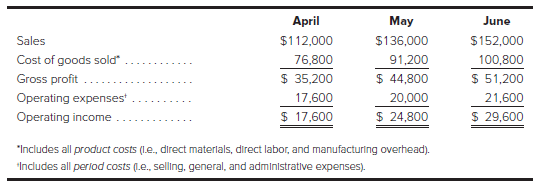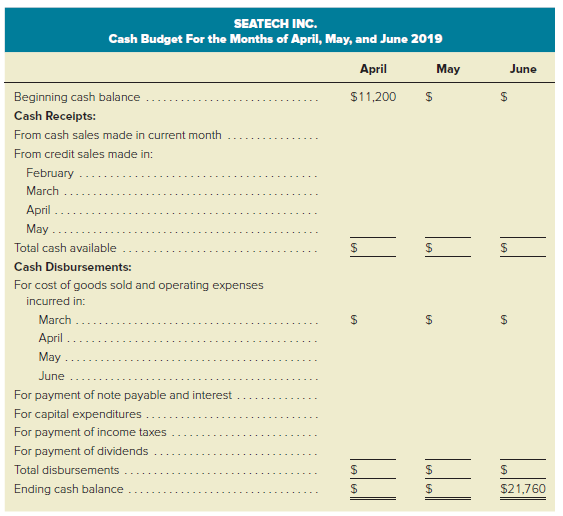Following are the budgeted income statements for the second quarter of 2019 for SeaTech Inc.: The company
Question:
Following are the budgeted income statements for the second quarter of 2019 for SeaTech Inc.:

The company expects about 40% of sales to be cash transactions. Of sales on account, 65% are expected to be collected in the first month after the sale is made, and 35% are expected to be collected in the second month after sale. Depreciation, insurance, and property taxes represent $9,600 of the estimated monthly cost of goods sold and $6,400 of the estimated monthly operating expenses. The annual insurance premium is paid in January, and the annual property taxes are paid in August. Of the remainder of the cost of goods sold and operating expenses, 90% are expected to be paid in the month in which they are incurred, and the balance is expected to be paid in the following month.
Current assets as of April 1, 2019, consist of cash of $11,200 and accounts receivable of $119,840 ($84,000 from March credit sales and $35,840 from February credit sales). Current liabilities as of April 1 consist of $14,400 of accounts payable for product costs incurred in March; $3,680 of accrued liabilities for operating expenses incurred in March; and a $38,000, 12%, 120-day note payable that is due on April 17, 2019.
An estimated income tax payment of $36,000 will be made in May. The regular quarterly dividend of $12,800 is expected to be declared in May and paid in June.
Capital expenditures amounting to $13,760 will be made in April.
Required:
a. Complete the monthly cash budgets for the second quarter of 2019 using the following format. Note that the ending cash balance for June is provided as a check figure.

b. Assume that management of SeaTech Inc. desires to maintain a minimum cash balance of $10,000 at the beginning of each month and has arranged a $50,000 line of credit with a local bank at an interest rate of 10% to ensure the availability of funds. Borrowing transactions are to occur only at the end of months in which the budgeted cash balance would otherwise fall short of the $10,000 minimum balance. Repayments of principal and interest are to occur at the end of the earliest month in which sufficient funds are expected to be available for repayment. Explain how this minimum cash balance requirement would affect the monthly cash budgets prepared in part a.
Accounts PayableAccounts payable (AP) are bills to be paid as part of the normal course of business.This is a standard accounting term, one of the most common liabilities, which normally appears in the balance sheet listing of liabilities. Businesses receive... Accounts Receivable
Accounts receivables are debts owed to your company, usually from sales on credit. Accounts receivable is business asset, the sum of the money owed to you by customers who haven’t paid.The standard procedure in business-to-business sales is that... Line of Credit
A line of credit (LOC) is a preset borrowing limit that can be used at any time. The borrower can take money out as needed until the limit is reached, and as money is repaid, it can be borrowed again in the case of an open line of credit. A LOC is...
Step by Step Answer:

Accounting What the Numbers Mean
ISBN: 978-1260565492
12th edition
Authors: David Marshall, Wayne McManus, Daniel Viele





